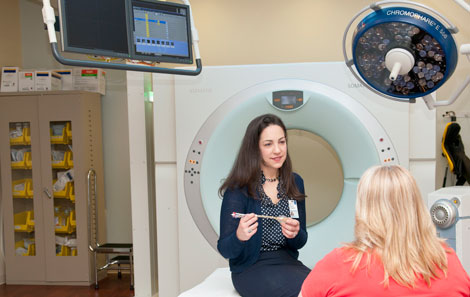Radiation therapy is a cancer treatment that uses high-energy X-ray or particles to destroy cancer cells. At UVA Cancer Center, radiation therapy is used in many different situations for the treatment of breast cancer patients.
- Radiation to the breast is often given after breast-conserving surgery to decrease the risk of the cancer coming back in the breast or nearby lymph nodes.
- Radiation is also sometimes recommended after a mastectomy in patients with large breast tumors or who have cancer that has spread to the lymph nodes.
- Radiation can also be used to treat cancer that has spread to other areas, such as the bones or brain.
Radiation can be delivered externally (external beam radiation) or internally (brachytherapy). The way the radiation therapy is given depends on the type and stage of cancer being treated.
- External beam radiation therapy is the standard type of radiation therapy. A machine is used to deliver radiation in the form of high energy x-rays from outside of the patient’s body.
- Brachytherapy involves the temporary placement of needles, balloons or catheters in the patient’s breast near the tumor site to deliver radiation from the inside. Brachytherapy may be used as an extra radiation boost with external beam radiation or for the sole treatment of small, localized tumors.
New Advances in Radiation Therapy
The University of Virginia offers several new techniques in radiation therapy for breast cancer.
Hypofractionated Radiation Therapy
Newer studies have shown that shorter courses of radiation therapy provide the same local control and cosmetic outcome as the longer conventional course of radiation therapy. A higher radiation dose is given each visit. Depending on the stage of breast cancer, this is a potential option for some patients.
Accelerated Partial Breast Irradiation (APBI)
APBI is a localized form of radiation treatment that targets just the tumor bed and a small amount of surrounding breast tissue. This can be achieved utilizing external beam radiation therapy or brachytherapy. The procedure requires close collaboration between the surgeon who removes the breast tumor and the radiation oncologist who treats the tumor after surgery.
Intraoperative Radiation Therapy (IORT)
IORT involves delivering a single, targeted, high-dose treatment of radiation therapy at the time of the patient’s breast surgery. At UVA, IORT is performed using a CT scanner so that the radiation oncologist can see the tumor bed and know exactly where to deliver the radiation. This also allows decreased radiation to normal tissues.
Deep Inspiratory Breath Hold (DIBH)
Studies have shown that it is very important to limit heart dose when treating left-sided breast cancers to prevent long-term complications such as heart attacks. On inspiration, the heart moves farther from the chest wall and breast allowing radiation to be delivered with minimal radiation exposure to the heart. Patients are instructed to take a deep breath and are monitored during treatment. The radiation beam is only turned on during inspiration and automatically shuts off if the patient needs to breathe.
Image-Guided Radiation Therapy (IGRT)
Images are obtained prior to treatment to locate the radiation target just before radiation is delivered with the patient in the treatment position. This allows more accurate delivery of radiation.
While all of these technical innovations are available at UVA Cancer Center, some applications are limited to clinical trials. The radiation oncologist can discuss the specifics of treatment and available options based on the type and stage of the patient’s breast cancer at the time of consultation.
